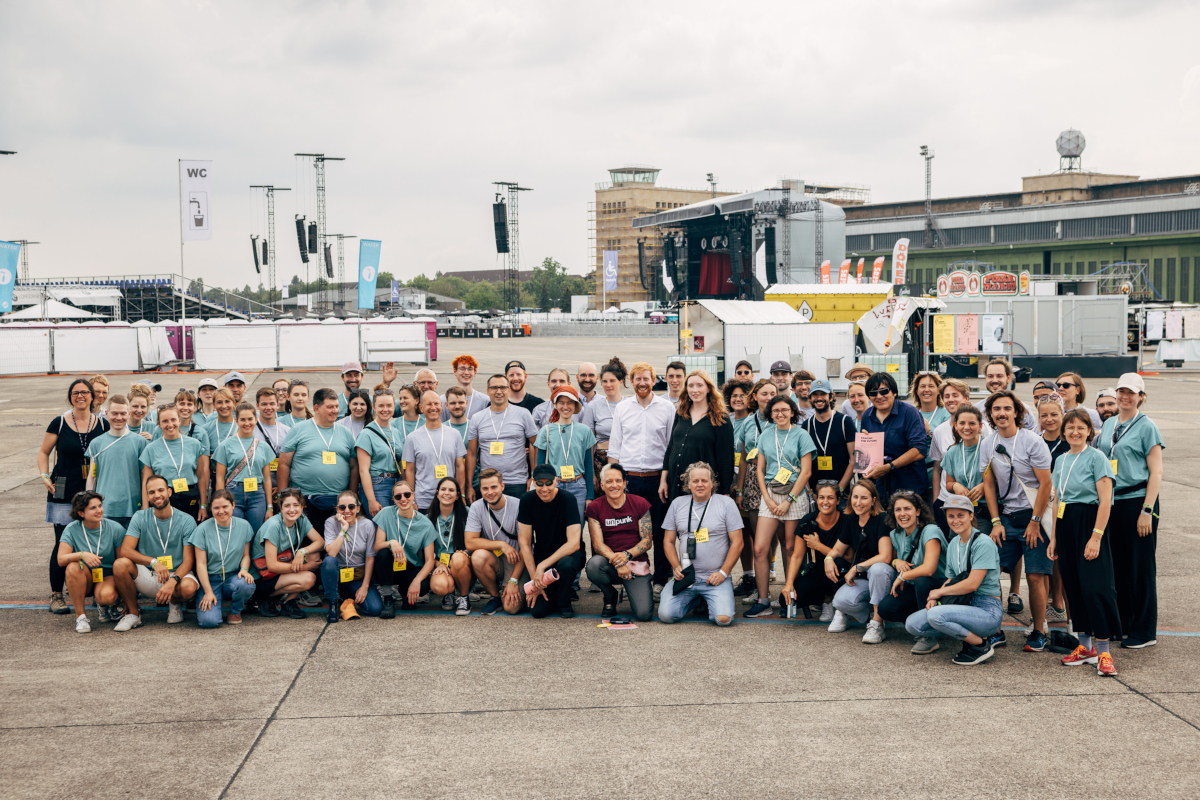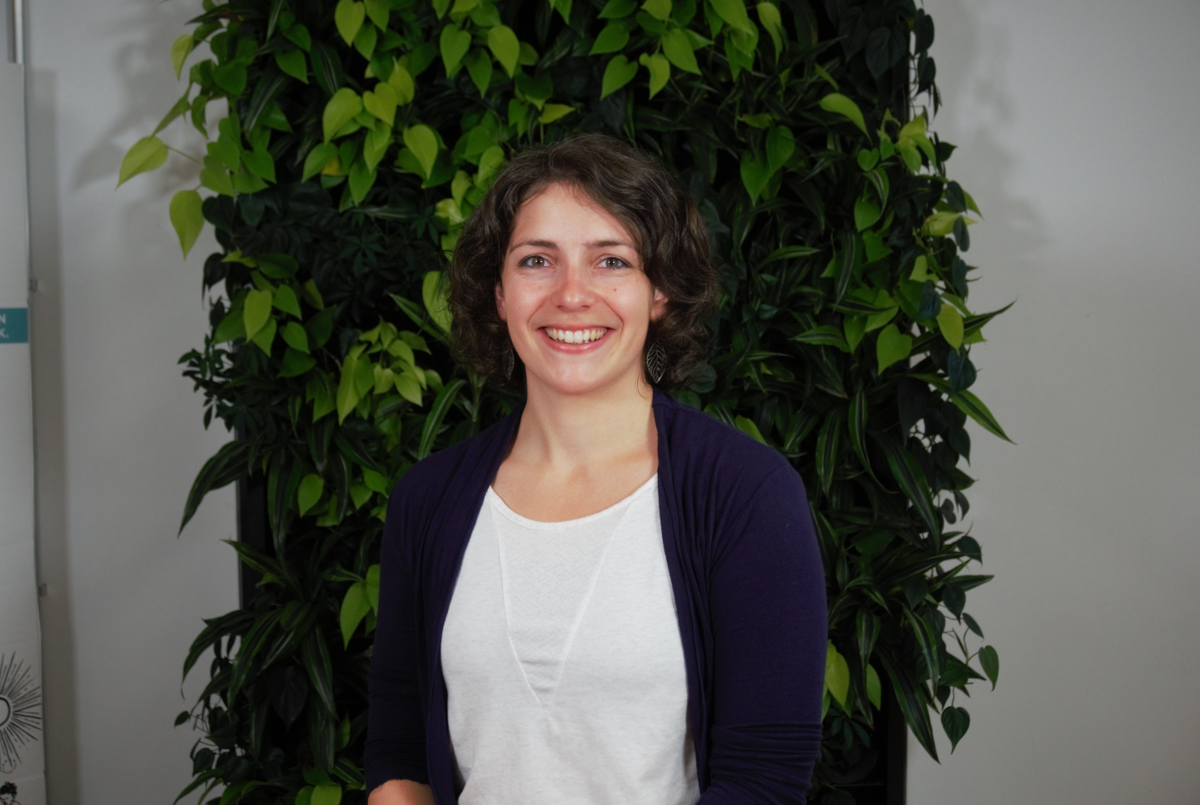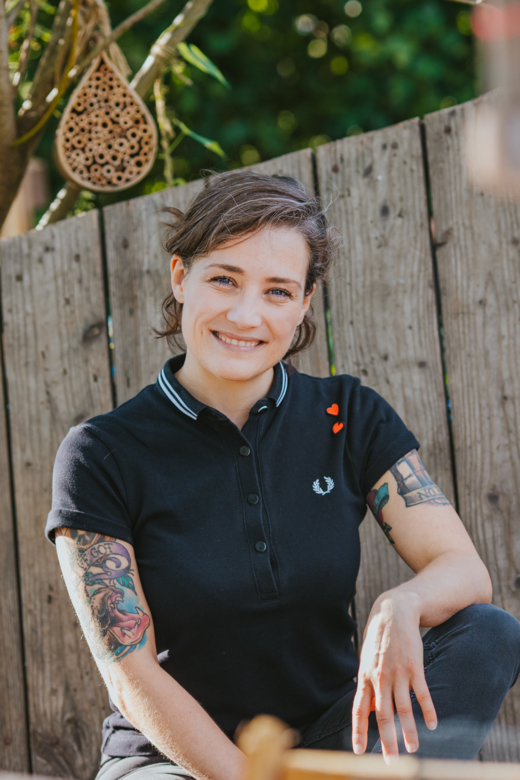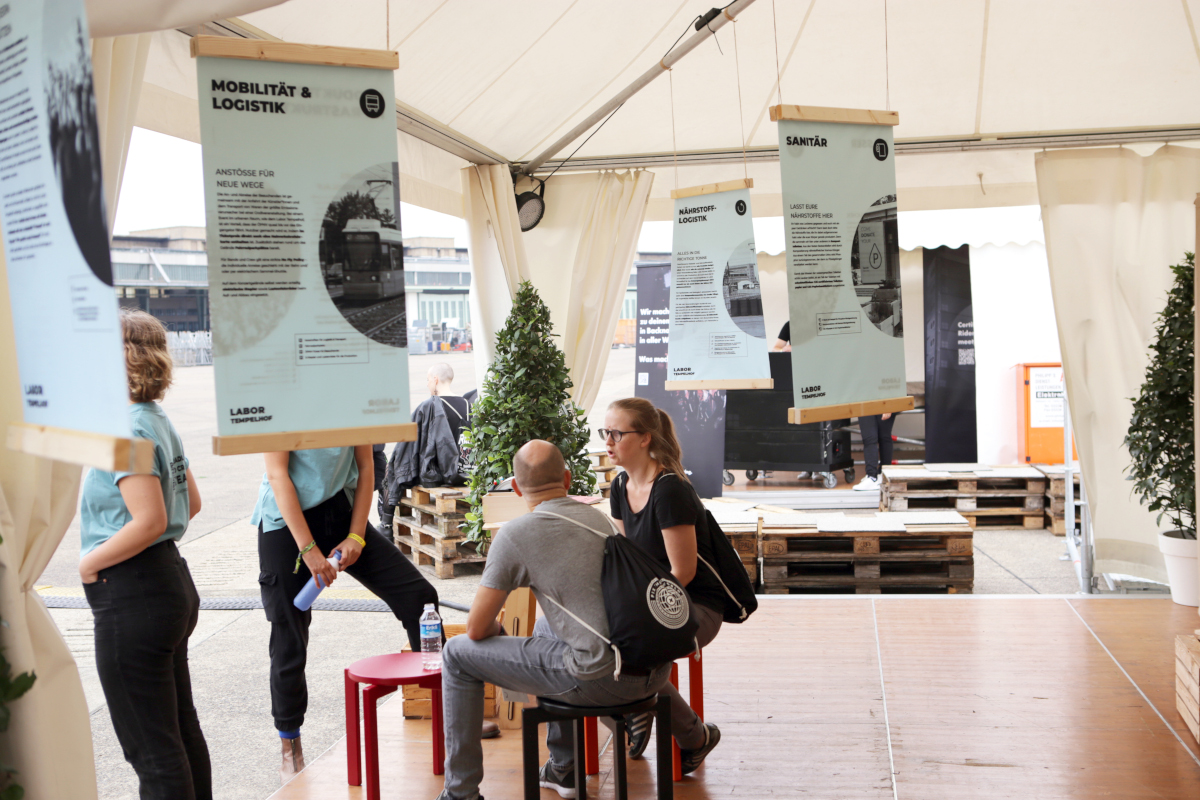Sustainability, Consultation
Björn Barutzki: "We see ourselves as cultivators"
What sustainability advice and services are available for Berlin companies …

Events consume an average of 37 kg of CO₂ per participant - a disaster in terms of climate change. The Labor Tempelhof has therefore organized three concerts in collaboration with the bands Die Ärzte and Die Toten Hosen, through which all materials are to be returned to biological and technical cycles. How does the concept work?
CCB Magazine: Hello Katrin and Jonna, with Labor Tempelhof you have launched an event concept based on Cradle to Cradle and sustainability criteria in order to return as many materials as possible to cycles. The focus was on four planned concerts by the bands Die Ärzte and Die Toten Hosen for a "climate-positive future," three of which ultimately took place. How did the bands participate in this process?
Katrin Wipper: The climate crisis concerns us all, so we are all the more pleased that the two bands have made their concerts available for Labor Tempelhof. Both Ärzte and Die Toten Hosen have accompanied the complete path and are leading the way as examples.

CCB Magazine:For those who don't know what C2C is all about, please explain the concept briefly.
Jonna Clasen: Cradle to Cradle is an approach to a circular economy that begins with the design of products and processes. The aim is to design all products in such a way that the resources used for them can circulate in biological and technical cycles and thus never become worthless waste. To this end, products are designed on the basis of their usage scenario: If components of a product inevitably end up in the environment, such as the abrasion from shoe soles, this abrasion must be suitable and biodegradable. In the case of products whose components do not end up in the environment, the materials and raw materials must be separable and recyclable by type so that they can be continuously reused In addition to the recyclability and material health of products, this approach includes the use of exclusively renewable energy from recyclable plants, the development of fertile soils, the recirculation of water and the management of greenhouse gases.
We need to change the political and economic framework. Only then will it be possible for event organizers to plan and implement climate- and resource-positive events
CCB Magazine: The Labor Tempelhof is a joint project of the initiators Cradle to Cradle NGO, KKT GmbH - Kikis Kleiner Tourneeservice, Loft Concerts GmbH and Side By Side Eventsupport GmbH. How do you manage to organize events in such a way that as many materials as possible are recyclable?
Katrin Wipper: In the course of the project, discussions were first held with all the trades involved about the materials used at the event. At this stage, it is difficult to ensure 100 percent recyclability, as many materials are not within the direct sphere of influence and action of the event organizers. For example, in the temporary rental of structures and tents. In addition, some cycles are not closed at the end of the use phase - for many products, a functioning separation or recycling system is not yet guaranteed. These are the lessons learned from this project, which we are constantly working on to improve.
Jonna Clasen: Even beyond the product level, we have tried to close as many material flows as possible. We were very successful with the sanitary concept. Among other things, we used composting toilets in which feces and urine were collected separately. The feces were composted into humus as part of the ZirkulierBar project in Eberswalde, and the phosphorus contained in the urine was recovered and processed into liquid fertilizer. In the portable toilets used, a biodegradable agent was used instead of the usual environmentally harmful cleaning chemicals. These toilets were diverted to Waßmannsdorf for emptying, the only wastewater treatment plant in Berlin where phosphorus is already recovered from sewage sludge ash and used to produce fertilizer. Overall, we were thus able to return nutrients to the cycles from more than 80 percent of all toilets.

CCB Magazine: The project consists of three project stages. What are they?
Jonna Clasen: The concerts and the measures implemented were the first project stage. In the EU, we have politically set ourselves the goal of a circular economy. And Labor Tempelhof shows that we urgently need to change the political and economic framework if we are serious about this goal. Only then will it be easier for event organizers to plan and implement truly climate- and resource-positive events in the future. For this reason, the project has produced a report with recommendations for action for policymakers, and we are working on a guidebook for the event industry in which we present the measurable results of the concerts and describe where particularly large levers for circularity lie and how they can be moved. This will be followed next year by a series of events and a four-month exhibition in Berlin on the project. And the final stage of the project is the impact we have been able to make through the lab: We want to see who we can inspire with it, which future events will take C2C as a benchmark and what we were able to move in politics. The Green Culture Desk, which is to advise event organizers on sustainable development, is a declared goal of the German government in the coalition agreement. We can imagine many synergies here, for example.
Where C2C has not yet been able to scale up, this has not been due to a lack of innovation or technology, but to a lack of time or the wrong or missing framework conditions
CCB Magazine: You have already mentioned that one hundred percent recyclability is not yet possible at this point in time. The planning and execution of an event generates an average of 37 kg of CO₂ per participant. What are the biggest problems? How do you solve them?
Jonna Clasen: When considering sustainability, it is often forgotten that climate and resource problems are interrelated. The problems don't just arise on a concert site, but already in the supply chain of all the products needed for an event. For a conventionally produced white T-shirt, more than 2.000 liters of water are used in production, according to various studies. For a dyed or printed T-shirt, and this is the case for merchandise, for example, it is many times more. We were able to reduce water consumption at the Labor Tempelhof concerts by about 50 percent, according to current calculations. And most of this reduction is due to the supply chains of C2C and C2C-inspired products and processes, such as the proportion of C2C-certified T-shirts in the merch of the two bands. The predominantly plant-based food offerings also require significantly less water in production than meat-heavy offerings.
Katrin Wipper: The biggest CO₂ emitters at an event are mobility, especially fan travel, energy and food. Together, they account for around 90 percent of an event's total CO₂ emissions. In concrete terms, this means implementing a well-communicated mobility concept that provides incentives for climate-friendly travel. At Labor Tempelhof, this was implemented by including free public transport travel in the concert ticket of all fans and providing free and supervised bicycle parking on site. Revolutionary was the fact that these large open-air events could be covered almost 100 percent by festival electricity, which was of course green electricity, which meant a massive logistical and financial extra effort in production. The food offered to visitors on site consisted of 60 percent vegetarian dishes, and the catering in the backstage was 100 percent vegan and vegetarian.

CCB Magazine: And where does the C2C concept reach its limits? What cannot be implemented on a C2C basis?
Katrin Wipper: Cradle to Cradle's greatest leverage is directly with the manufacturers of products and event service providers: directly where materials and manufacturing processes can be influenced. Once the finished product of an event service provider, for example a company that rents out stage elements for concerts, has been manufactured, it is difficult for event organizers to influence the materials used afterwards.
Jonna Clasen: That's why it was so important to talk to the trades, to create awareness for the topic and to initiate a change in business and politics. In theory, all aspects of an event can be implemented according to C2C. Where C2C could not yet be scaled up, it was not due to a lack of innovation or technology, but to a lack of time or the wrong or missing framework conditions.
CCB Magazine: Events cost a lot of money. Do you save money by switching to C2C or do you end up paying for it?
Jonna Clasen: That depends on which costs you look at. If follow-up costs for environmental and health damage caused by conventional products are included, then a C2C solution is already more economical today. But many products or processes that are harmful to the environment or health are subsidized or given tax breaks today. As long as this is the case, projects like the Labor Tempelhof are needed to highlight this flaw in the system, talk about it and simply have the courage to do things very differently.
Katrin Wipper: The devil is often in the details. In the case of the present concerts, immense additional costs were incurred in some cases by switching to concerts that were as climate- and resource-friendly as possible. However, this will change in the course of the next few years: The use of fixed power at concerts, as opposed to diesel generators at conventional shows, was more expensive. If the prices for fixed green power and fuel change in the future, and if they are priced at the real cost to the environment, the ratio will reverse. So we are on the way at the moment.



CCB Magazine: Why are there almost no C2C-based concerts and events so far?
Katrin Wipper: There are certainly festivals that rely on circularity, such as the DGTL Festival in Amsterdam. The organizers have the advantage that they have already established constant conditions - event space, event team, etc. - and can constantly improve from year to year and build on their experience. This is sometimes more difficult for concerts with changing locations and teams. Fortunately, however, the industry is moving in the right direction. For example, Wacken Open Air announced this year that it wants to be Cradle to Cradle compliant by 2030, and at ADE (Amsterdam Dance Event) 46 European festivals - including Roskilde, Boomtown, EXIT Fest - have just joined forces to act more sustainably and more circularly in the future and to share the accumulated knowledge among themselves.
There is an enormous need for changes and additions to the laws at EU and federal level in order to create the right framework for a true circular economy according to C2C
CCB Magazine: The C2C concept is also criticized. One criticism is that it does not move away from increased consumption, but assumes that much can still be produced and consumed through eternal cycles - which still consumes a lot of energy, often from non-sustainable sources. Jacob Sylvester Bilabel of the Aktionsnetzwerk Nachhaltigkeit therefore proposes switching to hydrogen from renewable sources, which remains emission-free when converted back into electricity. Would that be the solution?
Jonna Clasen: Cradle to Cradle also includes the exclusive use of renewable energies. And from plants that can be recycled, because the way photovoltaic systems and wind turbine rotor blades are built today creates a huge hazardous waste problem in the future. Hydrogen from renewable sources can be part of the solution - depending on which region of the world we are talking about. In countries of the Global South, for example, the surpluses from solar energy are high, so it may make sense to produce hydrogen from it. In other regions, the cost of doing so is extremely high compared to the efficiency of the technology. It is neither likely nor reasonable that in the future everywhere in the world the energy demand from renewable sources will be met in only one way. Such one-size-fits-all solutions neglect regional conditions and the varying availability, effectiveness and efficiency of resources - whether finite or renewable.
CCB Magazine: What decisions are needed at the political level to make C2C concerts and events standard?
Jonna Clasen: Quite a lot. For the report, we took a close look at which laws will be discussed at EU and federal level in the next few years as part of the Circular Economy Action Plan. And in every single law, there is an enormous need for changes and additions. It starts with eliminating subsidies and tax breaks for environmentally harmful products and processes, such as the energy tax exemption for the production of Virgin Plastic from crude oil. We need to start positively defining what materials and substances should be used in the future in buildings and constructions, in textiles or in consumer goods and their packaging, so that they are recyclable and healthy for people and the environment. We need an agricultural policy that promotes regenerative use of water and soil and does not continue to subsidize quantity instead of quality. At the Labor Tempelhof concerts, 60.000 people were on site each day. They have to eat, drink, go to the toilet, and buy things in the form of merch, just like in a medium-sized city. If we create the right framework for a true circular economy based on C2C, we will also ensure that climate- and resource-positive events become the new normal in the future.
Category: Specials
Also a good read
Subscribe to our monthly newsletter!